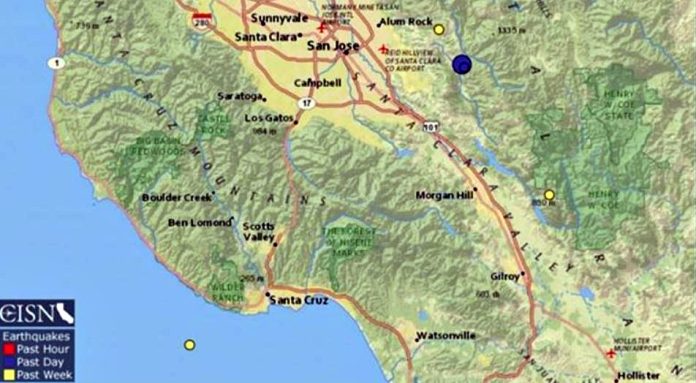
Oct. 26 (UPI) — Four small aftershocks have rattled northern California since Tuesday’s large magnitude 5.1 earthquake struck east of San Jose, according to the California Geological Survey, which warned residents to expect more shaking in the coming days.
The initial 5.1-magnitude quake struck at 11:42 a.m. PDT on Tuesday, about 12 miles east of San Jose, and is the largest to strike the San Francisco Bay Area in eight years. The temblor was centered in Joseph D. Grant County Park and was felt as far away as Salinas, Point Reyes and Stockton.
About five minutes after the initial earthquake, a 3.1 aftershock struck, according to the U.S. Geological Survey. The California Geological Survey has recorded three additional aftershocks, greater than magnitude 2.0, as of 8 p.m. PDT.
“It was pretty strong. I’ve been in earthquakes before. It was a pretty good shake,” one ranger at the 10,882 acre park told The Mercury News. “It was a rolling shake, not a jarring shake. It lasted about seven seconds. I didn’t see any damage. No broken windows, nothing off the shelves. But I’m still checking around.”
Seismologists said the earthquake epicenter was about four miles underground on the Calaveras Fault, which runs 76 miles from Hollister to Danville and is linked to the Hayward Fault. It is the same location where a larger 6.2 quake occurred in 1984 and a 4.1 earthquake hit in 2017.
“The Calaveras moves more slowly, it has less of the total motion going on there than on the San Andreas, so it moves less often or releases less energy,” Dr. Lucy Jones, a seismologist at California Institute of Technology, told KGO-TV. “But it seems to have the smaller earthquakes a lot more often. It’s considered capable of a six and a half or so. But unlike the San Andreas, it’s not going to have, you know, a magnitude eight.”
Tuesday’s quake was the largest to strike the Bay Area since the 6.0 Napa quake in 2014 that damaged hundreds of buildings.
As of Tuesday night, there were no reports of any damage or injury from the quake. Public works employees evaluated infrastructure for any possible damage. All trains for BART, Caltrain and VTA were stopped temporarily right after the quake as a precaution.
Pacific Gas & Electric workers checked natural gas and electrical lines, but there were no reports of damage. The Santa Clara Valley Water District also inspected the agency’s three water treatment plants.
The San Jose Sharks hosted the Las Vegas Golden Knights on Tuesday night at SAP Center, where the National Hockey League team ordered a full-scale inspection of the facility right after the quake.
“The SAP Center engineering staff completed a thorough inspection of all systems in the venue after the earthquake,” said Jim Sparaco, spokesman for the San Jose Sharks. “Everything is operating as it should be.”
The Bay Area sits between the Pacific and North American tectonic plates and is prone to earthquakes.
Tuesday’s earthquake struck just a week after the 33rd anniversary of the deadly 1989 Loma Prieta quake in the Santa Cruz Mountains. The 6.9 magnitude quake rocked the Bay Area, right before a World Series game between the San Francisco Giants and the Oakland A’s, killing 62 people and causing $6 billion in damage that included a collapsed portion of the Bay Bridge.
The San Francisco earthquake of 1906 was even larger with an estimated magnitude of 8.3.
Mobile phones played a new role in Tuesday’s earthquake with the #ShakeAlert system, which notified a number of residents before the quake hit. While Shake Alert can not predict earthquakes, it can detect a quake’s initial waves. The system, created by the U.S. Geological Survey, has about 903 sensors buried throughout California with more to be added.
Seismologists are warning residents there is still a chance of aftershocks and a one in 100 chance of an aftershock greater than magnitude 5.0 within the next 24 hours, according to Annemarie Baltay with the U.S. Geological Survey who predicted 10 to 15 aftershocks greater than 3.0 over the next week.
“Additional shaking from aftershocks can be expected,” the California Geological Survey tweeted Tuesday. “We are continuing to monitor this region.”






